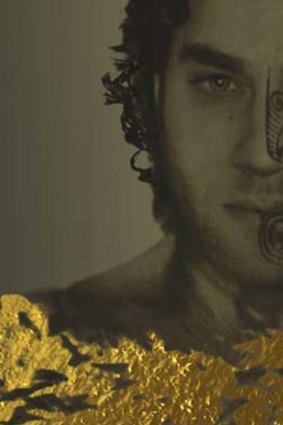This was published 12 years ago
Warrior's legend shapes operatic journey
A new production brings to life the story of a Maori transported to Tasmania for defending his people's land.
By Joyce Morgan
For nearly 150 years, a Maori warrior lay buried on windswept Maria Island off Tasmania's east coast, a victim of colonial injustice. It was not just Britain's convicts who were transported to the penal settlement. Hohepa Te Umuroa was among a handful of Maoris shipped across the Tasman and incarcerated.
Now this little known episode is set to become an opera starring Phillip Rhodes in the title role and with a libretto sung partly in Maori. It will premier as part of the New Zealand International Arts Festival.

Face on … a portrait of Phillip Rhodes, who plays the title role of Hohepa Te Umuroa.
New Zealand composer and librettist Jenny McLeod says she learnt of Hohepa's story around the time his remains were belatedly returned to his ancestral land in 1988.
Through a choral festival she was involved in, she became friends with the late spiritual leader of the Whanganui people, who gave her permission to tell the tale.
She was drawn to the story of resistance to colonial rule intertwined with friendship between Maori and Europeans.
''I thought it had the qualities of a golden legend,'' McLeod says. ''And in new countries we need legends.''
Hohepa was a young man when in the mid-19th century an English couple, Thomas and Jane Mason, arrived in the Hutt Valley and a friendship developed between them.
But when land disputes in the valley escalated and the imposition of the British justice system resulted in bloodshed, the Masons moved to Tasmania for safety.
''Initially the [Maori] welcomed the [English] but gradually disillusionment set in,'' McLeod says.
Tensions increased when Sir George Grey, a former governor of South Australia, was appointed governor of New Zealand and arrived.
''Grey kicked [Maori] people off their land,'' McLeod says. ''It was unjust and illegal.''
Among the dispossessed was Hohepa, who resisted colonial rule. He was eventually captured and sentenced with other Maoris to life with hard labour at Port Arthur.
''That was effectively a death sentence,'' McLeod says.
In Hobart, Maori-speaking Thomas volunteered to translate for the newly arrived prisoners, unaware that his former friend was among them.
''Mason was the first to visit these prisoners and he found they were his friends and neighbours. He didn't know until he got there,'' McLeod says.
Mason, a Quaker interested in prison reform, spoke up for Hohepa and the Maori prisoners, urging more lenient treatment. While in Hobart penitentiary, Hohepa was drawn by colonial artist John Skinner Prout. The portrait, in which Hohepa stands wrapped in a traditional cape with facial tattoos, is in the British Museum.
Eventually, instead of going to Port Arthur, Hohepa was transferred to Maria Island, where he later died and was buried. But in 1988 elders from Whanganui brought home his remains, amid much ceremony.
McLeod is expecting descendants of Hohepa and the Masons will attend the production.
The opera is one of the most ambitious commissions of Lissa Twomey's third and final festival.
Since crossing the ditch to Wellington, Twomey has produced a lively program of international and local works.
''There has been a tradition of opera in the festival but it's been more grand-scale European opera,'' she says.
Instead, Twomey broke the mould and commissioned a local composer to create an opera based on a local story.
Other local work in the program is already creating international interest, including Conch Theatre's Masi, a collaboration with British illusionist Paul Kieve, who was magic adviser to the Harry Potter films, and a Maori version of Troilus and Cressida. The latter production will transfer to London's Globe Theatre later this year as part of the cultural program for the Olympic Games.
''I'm proud of this year's program,'' Twomey says. ''The new New Zealand work has a context within the program. There's a real aesthetic. Hohepa is one of those.''
Internationally, British theatre company Kneehigh will venture into the murky woods of the unconscious with their retelling of a Brothers Grimm fairytale in The Wild Bride.
Belgian-based choreographer Sidi Larbi Cherkaoui, whose production Babel was a hit of this year's Sydney Festival, will return to Wellington with his new work Tezuka, inspired by the father of Japanese manga.
''There's a few companies I've invited back,'' Twomey says. ''You do so much to introduce an artist or a company to an audience.''
Twomey, a former associate artistic director of the Sydney Festival, will return to the city later this year.
The New Zealand International Art Festival begins on Friday. Hohepa premiers on March 15.